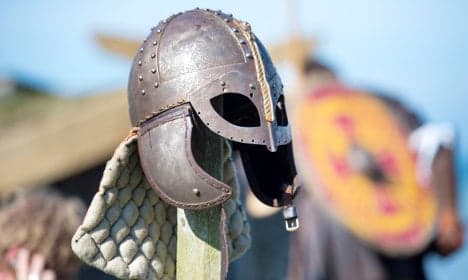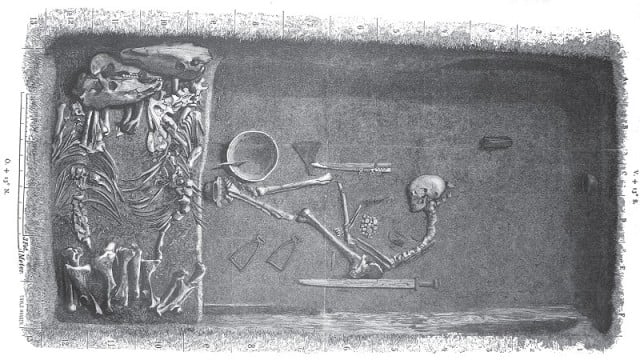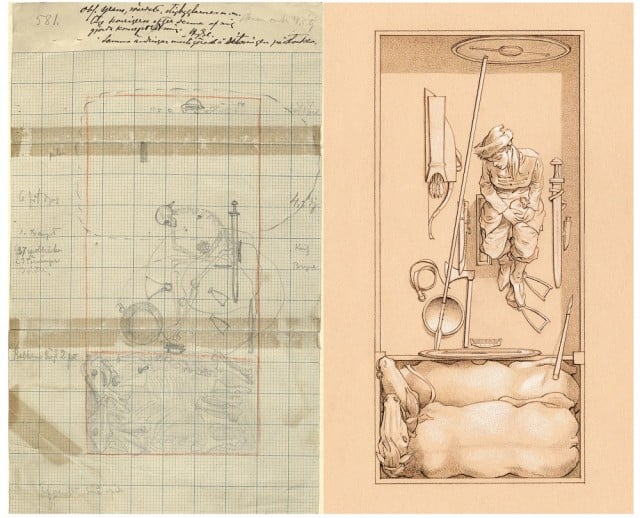Viking warrior found in Sweden was a woman, researchers confirm

Have researchers finally discovered Sweden's real-life version of Lady Brienne of Tarth or Xena the Warrior Princess? New evidence suggest they actually have…
For more than a century, archaeologists and historians have assumed that the remains of a person found buried along with arms and horses in one of the most spectacular graves discovered in the Viking Age town of Birka, in Sweden, belonged to a man. Turns out they were wrong. Osteology- and DNA tests now show that that he has always been a she, and she was most likely a powerful military leader.
“It’s actually a woman, somewhere over the age of 30 and fairly tall too, measuring around 170 centimetres,” Charlotte Hedenstierna-Jonson, an archeologist at Uppsala University, told The Local of the findings that were published in the American Journal of Physical Anthropology on Friday.
“Aside from the complete warrior equipment buried along with her – a sword, an axe, a spear, armour-piercing arrows, a battle knife, shields, and two horses – she had a board game in her lap, or more of a war-planning game used to try out battle tactics and strategies, which indicates she was a powerful military leader. She’s most likely planned, led and taken part in battles,” she said.
READ ALSO: Ten words you didn't know came from the Vikings

What the grave may have looked like. Illustration by Evald Hansen based on Hjalmar Stolpe's excavations at Birka in the 19th century (Stolpe 1889).
READ MORE: Why Games of Thrones is based on Sweden
The grave, which Hedenstierna-Jonson describes as the world’s “ultimate warrior Viking grave”, was discovered and excavated by Swedish archeologist Hjalmar Stolpe at the end of the 19th century. Because of the “manly” warrior equipment found in the grave, it was just assumed – rather than proven – that the remains were that of a man.
But a few years ago, Anna Kjellström, an osteologist at the Stockholm University, brought out the remains to study them for another research project and noticed that something was amiss. The cheekbones were finer and thinner than that of a man, and the hip bones were typically feminine. An osteological analysis was carried out, lending even more support to her suspicion.
Now, however, a DNA-analysis has been carried out, clearly confirming that the Viking warrior was indeed a woman.
“This image of the male warrior in a patriarchal society was reinforced by research traditions and contemporary preconceptions. Hence, the biological sex of the individual was taken for granted,” Hedenstierna-Jonson, Kjellström and the eight other researchers behind the study, wrote in their report.
IN PICTURES: Stockholm's new Viking museum

Another drawing of what the grave may have looked like. Illustration: Þórhallur Þráinsson (copyright: Neil Price)
“Though some Viking women buried with weapons are known, a female warrior of this importance has never been determined and Viking scholars have been reluctant to acknowledge the agency of women with weapons,” they said.
Hedenstierna-Jonson said the woman was likely a warrior herself.
“You can’t reach such a high (military) position without having warrior experience, so it’s reasonable to believe that she took part in battles.”
Hedenstierna-Jonson described it as a fantastic find, but said it is unlikely to completely up-end historians’ view of the Viking society as being patriarchal, mainly constituting of male warriors.
“It was probably quite unusual (for a woman to be a military leader), but in this case, it probably had more to do with her role in society and the family she was from, and that carrying more importance than her gender.”
Hedenstierna-Jonson said that since the first indications came through that the warrior was a woman, the researchers have been met with a fair share of skepticism, with critics questioning whether the bones analyzed are actually from that specific grave.
“I think that’s because of how we view history, and many of us would like to think that we live in the best (and more gender-equal) of worlds now.”
Comments
See Also
For more than a century, archaeologists and historians have assumed that the remains of a person found buried along with arms and horses in one of the most spectacular graves discovered in the Viking Age town of Birka, in Sweden, belonged to a man. Turns out they were wrong. Osteology- and DNA tests now show that that he has always been a she, and she was most likely a powerful military leader.
“It’s actually a woman, somewhere over the age of 30 and fairly tall too, measuring around 170 centimetres,” Charlotte Hedenstierna-Jonson, an archeologist at Uppsala University, told The Local of the findings that were published in the American Journal of Physical Anthropology on Friday.
“Aside from the complete warrior equipment buried along with her – a sword, an axe, a spear, armour-piercing arrows, a battle knife, shields, and two horses – she had a board game in her lap, or more of a war-planning game used to try out battle tactics and strategies, which indicates she was a powerful military leader. She’s most likely planned, led and taken part in battles,” she said.
READ ALSO: Ten words you didn't know came from the Vikings

What the grave may have looked like. Illustration by Evald Hansen based on Hjalmar Stolpe's excavations at Birka in the 19th century (Stolpe 1889).
READ MORE: Why Games of Thrones is based on Sweden
The grave, which Hedenstierna-Jonson describes as the world’s “ultimate warrior Viking grave”, was discovered and excavated by Swedish archeologist Hjalmar Stolpe at the end of the 19th century. Because of the “manly” warrior equipment found in the grave, it was just assumed – rather than proven – that the remains were that of a man.
But a few years ago, Anna Kjellström, an osteologist at the Stockholm University, brought out the remains to study them for another research project and noticed that something was amiss. The cheekbones were finer and thinner than that of a man, and the hip bones were typically feminine. An osteological analysis was carried out, lending even more support to her suspicion.
Now, however, a DNA-analysis has been carried out, clearly confirming that the Viking warrior was indeed a woman.
“This image of the male warrior in a patriarchal society was reinforced by research traditions and contemporary preconceptions. Hence, the biological sex of the individual was taken for granted,” Hedenstierna-Jonson, Kjellström and the eight other researchers behind the study, wrote in their report.
IN PICTURES: Stockholm's new Viking museum

Another drawing of what the grave may have looked like. Illustration: Þórhallur Þráinsson (copyright: Neil Price)
“Though some Viking women buried with weapons are known, a female warrior of this importance has never been determined and Viking scholars have been reluctant to acknowledge the agency of women with weapons,” they said.
Hedenstierna-Jonson said the woman was likely a warrior herself.
“You can’t reach such a high (military) position without having warrior experience, so it’s reasonable to believe that she took part in battles.”
Hedenstierna-Jonson described it as a fantastic find, but said it is unlikely to completely up-end historians’ view of the Viking society as being patriarchal, mainly constituting of male warriors.
“It was probably quite unusual (for a woman to be a military leader), but in this case, it probably had more to do with her role in society and the family she was from, and that carrying more importance than her gender.”
Hedenstierna-Jonson said that since the first indications came through that the warrior was a woman, the researchers have been met with a fair share of skepticism, with critics questioning whether the bones analyzed are actually from that specific grave.
“I think that’s because of how we view history, and many of us would like to think that we live in the best (and more gender-equal) of worlds now.”
Join the conversation in our comments section below. Share your own views and experience and if you have a question or suggestion for our journalists then email us at [email protected].
Please keep comments civil, constructive and on topic – and make sure to read our terms of use before getting involved.
Please log in here to leave a comment.